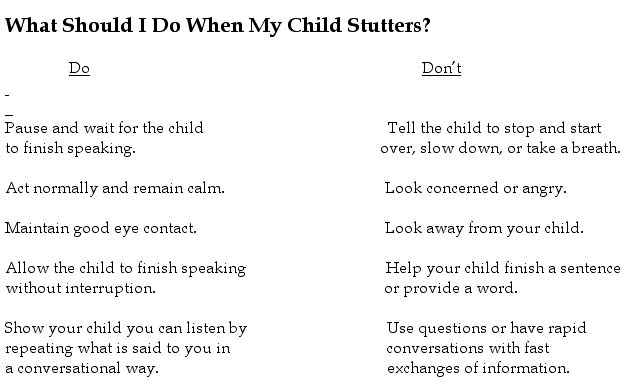The Many Voices of Paws
Helpful Hints From the PAWS Program
By Bonnie Arendt and Kristine Pintor

6 Steps to Help Children Speak More Fluently
- Decrease your own rate of speaking.
- Insert frequent pauses in your speech.
- Allow the child to initiate a great deal of the conversation.
- Decrease the number of questions and directives in your speech.
- Eliminate any interruptions. Allow the child to finish statements.
- Show your acceptance of the child no matter what through praise, love, giving smiles and hugs, and taking the time to listen and give them your undivided attention.
Guidelines for Reducing Environmental Stress
- Allow no one in the family to interrupt anyone else.
- Praise your child consistently for everything done well and for ever attempt, even if it’s not “perfect” to build self-confidence.
- Avoid using the word “no.”
- Make sure the child has adequate amounts of physical activity and rest.
- Empathize. If the child talks about feelings about speech, show that you value them.
- Try to eliminate experiences that are too frustrating for the child, such as trying to keep up with an older sibling.
- Make eating and bed times pleasant and not too hectic.
- Make speaking experiences happy.
- Avoid speaking or finishing sentences for the child.
- Build up fluency patterns through unison talking by saying nursery rhymes together.
- Avoid saying “hurry up” or similar phrases that make the child feel an urgency for doing something under time constraints.

Talking With Children
- Talk with, rather than at children
- Use vocabulary and sentences appropriate to the child’s age
- Make children feel that what they say is the most important thing in the world at that moment. Listen, allowing the child to begin conversations.
- Model corrections in a positive conversational manner.
- Be comfortable talking about feelings with the child.
- Nonverbal or body language is important when talking with children. Make sure you face the child giving your full attention and maintaining eye contact.
- Avoid asking open ended questions.
- If the child cries out, “I can’t say it!” show acceptance of the disfluency by commenting, That was hard for you, wasn’t it?” or “That one was tough.”
- If the child is pestering you to talk or hurried or excited say, “Take it easy. Be calm. Don’t get excited. I have the time to hear what you want to say.”
- Show you love your child every day.

